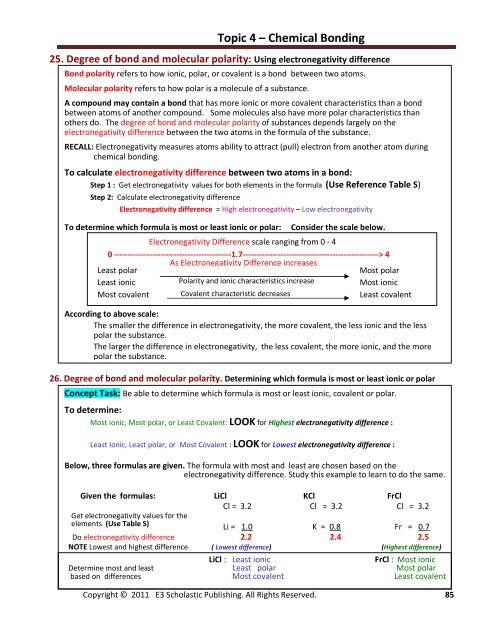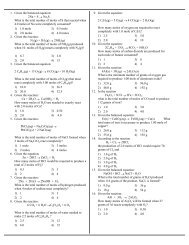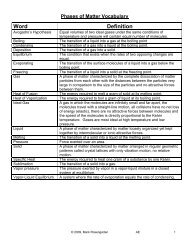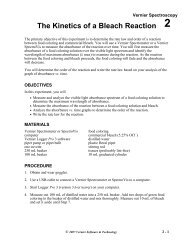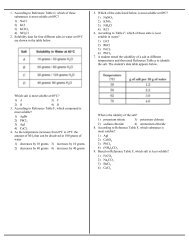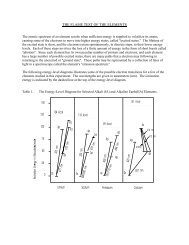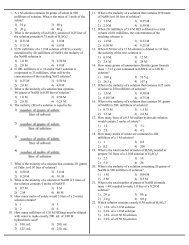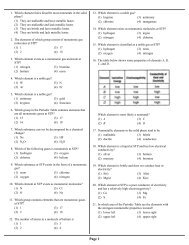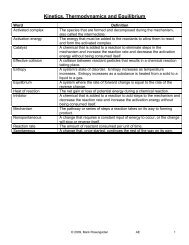Topic 1 - Matter and Energy - Revsworld
Topic 1 - Matter and Energy - Revsworld
Topic 1 - Matter and Energy - Revsworld
You also want an ePaper? Increase the reach of your titles
YUMPU automatically turns print PDFs into web optimized ePapers that Google loves.
<strong>Topic</strong> 4 .– Chemical Bonding<br />
25. Degree of bond <strong>and</strong> molecular polarity: Using electronegativity difference<br />
Bond polarity refers to how ionic, polar, or covalent is a bond between two atoms.<br />
Molecular polarity refers to how polar is a molecule of a substance.<br />
A compound may contain a bond that has more ionic or more covalent characteristics than a bond<br />
between atoms of another compound. Some molecules also have more polar characteristics than<br />
others do. The degree of bond <strong>and</strong> molecular polarity of substances depends largely on the<br />
electronegativity difference between the two atoms in the formula of the substance.<br />
RECALL: Electronegativity measures atoms ability to attract (pull) electron from another atom during<br />
chemical bonding.<br />
To calculate electronegativity difference between two atoms in a bond:<br />
Step 1 : Get electronegativity values for both elements in the formula (Use Reference Table S)<br />
Step 2: Calculate electronegativity difference<br />
Electronegativity difference = High electronegativity – Low electronegativity<br />
To determine which formula is most or least ionic or polar:<br />
Consider the scale below.<br />
Electronegativity Difference scale ranging from 0 - 4<br />
0 -------------------------------------------1.7--------------------------------------------------> 4<br />
Least polar<br />
As Electronegativity Difference increases<br />
Most polar<br />
Least ionic<br />
Polarity <strong>and</strong> ionic characteristics increase<br />
Most ionic<br />
Most covalent Covalent characteristic decreases<br />
Least covalent<br />
According to above scale:<br />
The smaller the difference in electronegativity, the more covalent, the less ionic <strong>and</strong> the less<br />
polar the substance.<br />
The larger the difference in electronegativity, the less covalent, the more ionic, <strong>and</strong> the more<br />
polar the substance.<br />
26. Degree of bond <strong>and</strong> molecular polarity. Determining which formula is most or least ionic or polar<br />
Concept Task: Be able to determine which formula is most or least ionic, covalent or polar.<br />
To determine:<br />
Most ionic, Most polar, or Least Covalent: LOOK for Highest electronegativity difference :<br />
Least Ionic, Least polar, or Most Covalent : LOOK for Lowest electronegativity difference :<br />
Below, three formulas are given. The formula with most <strong>and</strong> least are chosen based on the<br />
electronegativity difference. Study this example to learn to do the same.<br />
Given the formulas: LiCl KCl FrCl<br />
Cl = 3.2 Cl = 3.2 Cl = 3.2<br />
Get electronegativity values for the<br />
elements (Use Table S)<br />
Li = 1.0 K = 0.8 Fr = 0.7<br />
Do electronegativity difference 2.2 2.4 2.5<br />
NOTE Lowest <strong>and</strong> highest difference ( Lowest difference) (Highest difference)<br />
LiCl : Least ionic<br />
FrCl : Most ionic<br />
Determine most <strong>and</strong> least Least polar Most polar<br />
based on differences Most covalent Least covalent<br />
Copyright © 2011 E3 Scholastic Publishing. All Rights Reserved. 85


